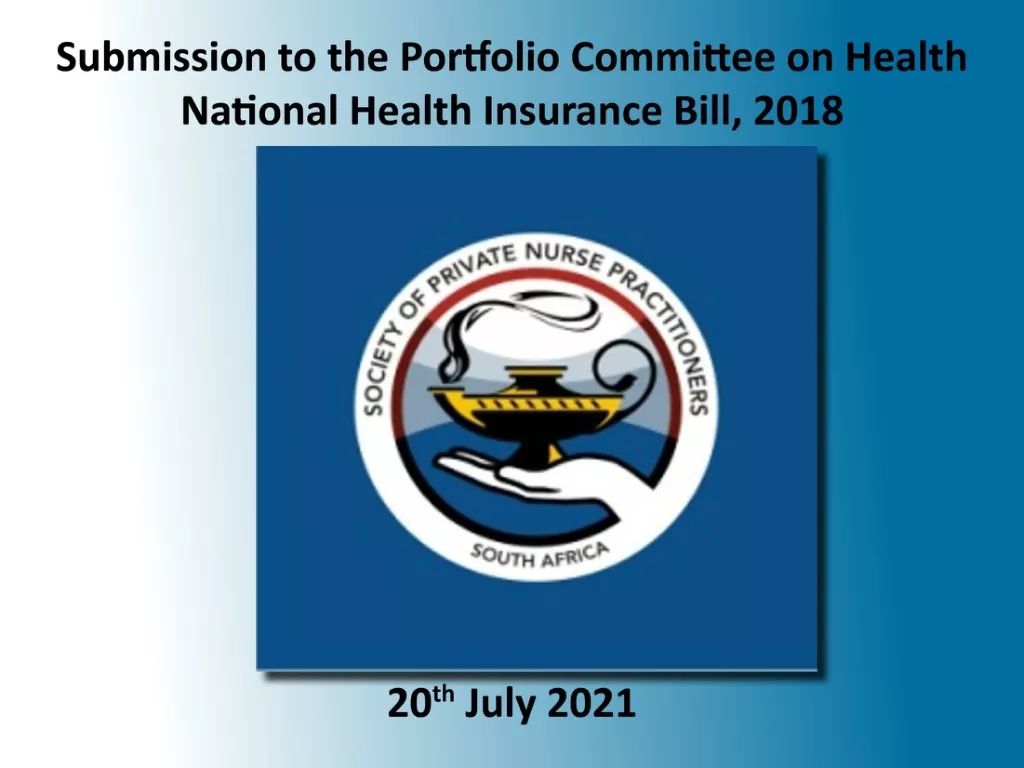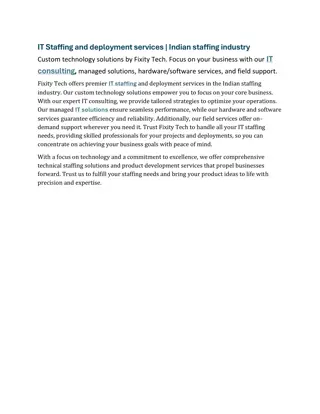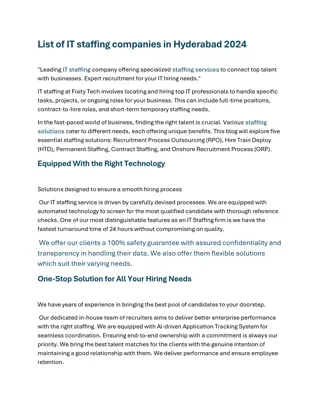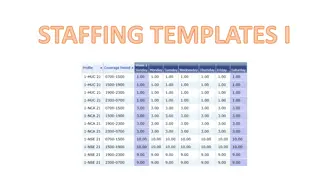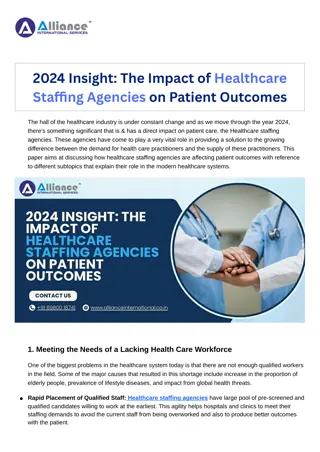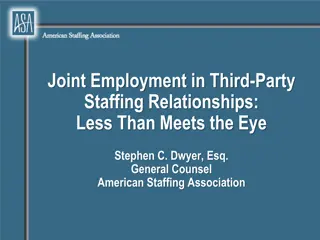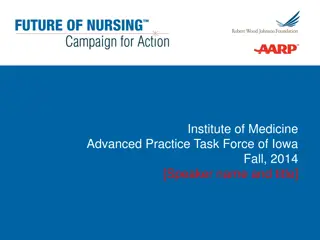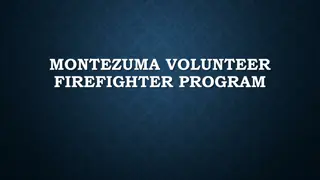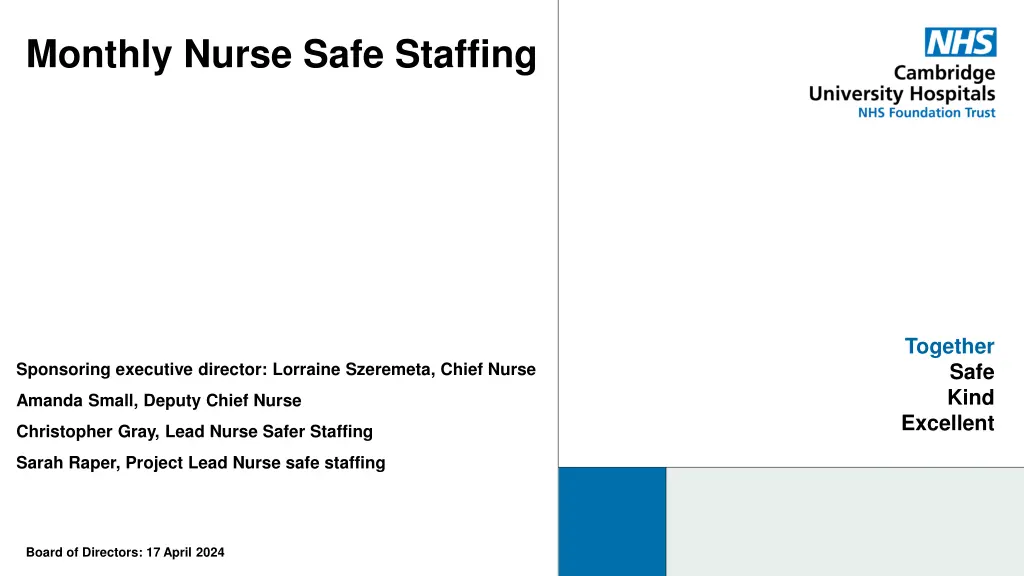
Monthly Nurse Safe Staffing Overview for February 2024
This summary provides insights into the nursing and midwifery staffing situation in February 2024, including vacancy rates, turnover, reasons for leaving, planned versus actual staffing, and mitigation strategies employed to ensure safe staffing levels.
Download Presentation

Please find below an Image/Link to download the presentation.
The content on the website is provided AS IS for your information and personal use only. It may not be sold, licensed, or shared on other websites without obtaining consent from the author. If you encounter any issues during the download, it is possible that the publisher has removed the file from their server.
You are allowed to download the files provided on this website for personal or commercial use, subject to the condition that they are used lawfully. All files are the property of their respective owners.
The content on the website is provided AS IS for your information and personal use only. It may not be sold, licensed, or shared on other websites without obtaining consent from the author.
E N D
Presentation Transcript
Monthly Nurse Safe Staffing Together Safe Kind Excellent Sponsoring executive director: Lorraine Szeremeta, Chief Nurse Amanda Small, Deputy Chief Nurse Christopher Gray, Lead Nurse Safer Staffing Sarah Raper, Project Lead Nurse safe staffing Board of Directors: 17 April 2024
Executive Summary This slide set provides an overview of the Nursing and Midwifery staffing position for February 2024. The vacancy position in February has remained relatively static for Registered Children s Nurses (RSCNs) at 20.6% (20.8% in January), Registered Midwives (RMs) at 0.36% (-0.8% in January) and Maternity Care Assistants (MCAs) at 10.7% (10.3% in January). There has been a reduction in the vacancy rate for Registered Nurses (RNs) to 7.7% from 9.2% in January and Health Care Support Workers (HCSWs) to 13.8% from 14.8% in January. The turnover rate in February remains high but is relatively static in all areas with HCSW (including MCAs) at 15.2% (15.1% in January), RNs at 10% (10.2% in January), RMs at 12% (12.3% in January) and RSCN s at 14.5% (14.9% in January). The main reason for leaving for all staff groups is voluntary resignation relocation. The leavers destination data demonstrates that 29.5% of RNs and 36.4% of RMs are leaving to take up employment in other NHS organisations. 21.2% of RMs are leaving for no employment compared to 9.5% of RNs. Conversely, the leavers destination is unknown for the majority of HCSWs (45%) and 11.5% are leaving for no employment. The planned versus actual staffing report demonstrates that 11 clinical areas reported <90% overall rota fill in February (12 in January). The overall fill rate for maternity has increased to 98.2% compared to 92.1% in January. The total unavailability of the workforce working time in January has decreased by 0.1%% to 28.4%. The majority of unavailability (14.9%) is due to planned annual leave. Sickness absence has decreased slightly in February to 6.8% (7.4% in January). Additionally, 1.3% of working time was unavailable due to other leave, 3.5% was due to study leave and 1.9% was due to supernumerary time. Any decrease in fill rate within midwifery is mitigated through acuity assessment and redeployment of non-clinical, managerial and specialist staff to cover gaps. Where safety concerns arise the escalation to divert policy is activated to balance risk and maintain safety. During these incidences 1:1 midwifery care is maintained, and supernumerary status of the coordinator is a priority. In order to mitigate staffing risks, the number of requests for bank workers remains high with an average of 2515 shifts per week requested for registered staff and 2344 shifts requested for Health care support workers and Maternity support workers per week with an average bank fill rate of 78% for registered staff and 61.28% for Health Care Support workers. In addition, the equivalent of 15.8 WTE agency workers are working across the divisions (15.79 WTE in January). Despite this, redeployment of nurses and midwives has remained necessary due to staff unavailability, with an average of 300 working hours being redeployed each day. The number of occasions that 1 critical care nurse has needed to care for more than 1 level 3 patient has decreased in February to 14 occasions compared to 26 in January. Additionally, there have been 77 occasions in February where there has been no side room coordinator (113 in January). Any concerns with regards to critical care staffing are escalated through the senior nurse of the day. Staffing has been supported through the use of temporary workers (agency and bank), enhanced bank rates and registered staff (non critical care trained) are redeployed from the operational pool and clinical areas on a shift-by-shift basis. Critical care have opened 3 of the beds that were closed due to staffing resulting in 55 open beds rather than 59 beds. Recruitment is ongoing to the vacant positions with a plan to open the remaining 4 beds when vacancy allows. 2
Combined Nursing and Midwifery Staffing Position Vacancy Rates Graph 1. Nursing and midwifery vacancy rates Vacancy position The combined vacancy rate for Registered Nurses (RNs) and Registered Midwives (RMs) has decreased to 7.2% in February from 8.5% in January. The vacancy rate for Health care support workers (HCSWs) including Maternity Care Assistants (MCAs) has decreased to 13.8% in February (14.6% in January). When broken down further into Nursing and Midwifery specific vacancies, the MCA workforce vacancy rate has increased slightly to 10.7% from 10.3% in January. The HCSW vacancy rate (excl MCA) has decreased to 13.8% from 14.8% in January. The HCSW (including MCAs) turnover rate remains high at 15.2% (15.1% in January). The main reason for HCSWs leaving is voluntary resignation relocation (31.4%) and the next highest reason is voluntary resignation work life balance (24.6%). The leavers destination is unknown for the majority of HCSWs (45%), 15.2% of HCSWs are leaving to take up employment in other NHS organisations and 11.5% are leaving for no employment. Graph 2. Healthcare Assistant vacancy rates 3
Staffing Position Vacancy Rates for Registered Nurses and Registered Midwives Graph 3. Registered Nurse vacancy rates Vacancy position The vacancy rate for RNs working in adult areas has decreased to 7.7% in February (9.2% in January) as illustrated in Graph 3. The vacancy rate for registered children's nurses has remained relatively static at 20.8% (20.6% in January). The vacancy rate for Registered Midwives has increased slightly to 0.36% in February compared to -0.8% in January illustrated in Graph 4. The turnover rate in February remains high, 10% for RNs in adult areas (10.2% in January), 12% for RMs (12.3% in January) and 14.5% registered children's nurses (14.9% in January). The main reasons for RMs leaving is voluntary resignation relocation (33.3%) and the next highest reason is voluntary resignation work life balance (21.2%). The main reason for RNs leaving is voluntary resignation relocation (40.9%). The leavers destination data demonstrates that 29.5% of RNs and 36.4% of RMs are leaving to take up employment in other NHS organisations. 21.2% of RMs are leaving for no employment compared with 9.5% of RNs. Graph 4. Registered Midwife vacancy rates 4
Unavailability for Registered Nurses, Midwives and Health Care Support Workers Graph 5. Unavailability of staff Unavailability of staff Unavailability relates to periods of time where an employee has been given leave from their regular duties. This might be due to circumstances such as annual leave, sick leave, study leave, carers leave etc. The total unavailability of the workforce working time in February has decreased by 0.1% to 28.4% as illustrated in Graph 5. Graph 6 illustrates the percentage breakdown of the type of unavailability. The majority of unavailability (14.9%) was due to planned annual leave which would have been accounted for in the department rosters. There was a high percentage of unplanned leave that would have impacted upon fill rates within the rosters. In February, sickness absence has remained high but has slightly decreased to 6.8% from 7.4% in January. Supernumerary has reduced to 1.9%, study leave has remained at 3.5% however, other leave has increased to 1.3%. Graph 6. Types of absence 5
Planned versus actual staffing Planned versus actual staffing Graph 7 illustrates trend data for all wards reporting < 90% rota fill. The number of areas reporting <90% rota fill for registered RN/RM has increased to 24 in February from 20 in January. The number of areas reporting <90% rota fill for HCSWs in February has decreased to 9 from 11 in January. The number of ward areas reporting overall fill rates of <90% in February has decreased to 11 compared to 12 in January. Appendix 1. details the exception reports for all areas reporting RN/RM fill rates of <90%. The number of occasions that 1 critical care nurse has needed to care for more than 1 level 3 patient has decreased in February to 14 occasions compared to 26 in January. Additionally, there have been 77 occasions where there has been no side room coordinator (113 in January). Any concerns with regards to critical care staffing is escalated through the senior nurse of the day. Staffing has been supported through the use of temporary workers (agency and bank) and registered staff (non critical care trained) are redeployed from the operational pool and clinical areas on a shift-by-shift basis. There was also short-term agreement to pay critical care trained staff bank enhancement to reduce the over all amount of GPICS breaches. Critical care have opened 3 of the beds that were closed due to staffing resulting in 55 open beds rather than 59 beds. Recruitment is ongoing to the vacant positions with a plan to open the remaining 4 beds when vacancy allows. Midwifery & MSW fill rate Graph 8 illustrates that the overall fill rate for maternity has increased to 98.2% in February form 92% in January which is higher than the 12-month average of 92.1%. The lowest fill rates have been seen on Lady Mary Ward (88%). Mitigated through redeployment of staff where required to meet acuity needs. 6
Staff deployment Staff deployment Graph 9 illustrates the movement of staff across wards to support safe staffing to ensure patient safety. This includes staff who are moved on an ad hoc basis (shift by shift) and shows which division they are deployed to. The number of substantive staff redeployed has decreased in February with 300 working hours being redeployed per day in February (367.5 hours in January). This equates to 26.11 long day or night shifts per day. Staffing is also being supported by the operational pool whereby bank staff book a bank shift on the understanding that they will work anywhere in the trust where support is required. Nursing Pipeline Appendix 2 provides detail on the forecasted position in relation to the number of adult RN vacancies based on FTE and includes UK experienced, UK newly qualified, apprenticeship route, EU and international up to March 2025. The current forecast demonstrates a year end band 5 RN vacancy position of 1.6% which exceeds the target of 5%. The RN adult pipeline for 2024/25 now reflects the reduction in international recruitment. This is a national concern and has been escalated to NHS England. Work is being undertaken to explore RN Recruitment initiatives including increasing the International Recruitment pay band and reviewing our shortlisting criteria. Appendix 3 provides detail on the forecasted position in relation to the number of Paediatric band 5 RN up to March 2025. Numbers are based on those interviewed and offered positions in addition to planned campaigns. The current forecast demonstrates a year end band 5 Paediatric RN vacancy position of 20.97% the predicted year end March 2025 of 3.21%. Appendix 4 provides detail on the forecasted position in relation to number of HCSW vacancies up to March 2025. The predicted year end vacancy rate is 13.3%. Due to some HCSWs being moved over to Band 3 HCSW position numbers prior to 01 February this has caused some discrepancies in the ESR data leading to an increased vacancy rate with this amalgamation, however our intention is to mitigate any increase by centralising all band 3 HCSW vacancies. The predicted year vacancy at end March 2025 is 0.9%. Whilst the recruitment pipeline is positive with multiple pipelines including apprenticeship routes, domestic and international recruitment, the predicted numbers are only achievable if the appropriate infrastructure is in place to support. 7
Red flags Red Flags A staffing red flag event is a warning sign that something may be wrong with nursing or midwifery staffing. If a staffing red flag event occurs, the registered nurse or midwife in charge of the service should be notified and necessary action taken to resolve the situation. Nursing red flags Graph 10 illustrates that there has been an increase in the number of red flags reported with 312 reported in February. The highest number of red flags reported in February was in relation to an unmet 1:1 specialling requirement (127 compared with 60 in January). A trust wide improvement project focusing on specialling is being developed to review specialling across the organisation. There has been an increase in 2 reportable red flags in February with the remaining all reducing. The increase was seen in omission of planned mobilisation/washes/obs and unplanned omission in providing medications. Maternity red flags The number of maternity red flags has decreased slightly from 179 in January to 156 in February. Graph 11 illustrates the red flags that have been reported with the highest reported being Delay of >2hours or more between admission for induction and initiation of process or subsequent prostaglandin administration where required (40% in February 38% in January). 2 other red flags have also increased Delay >6 hours in transfer to delivery unit during induction of labour (16% in February 11.7% in January) and unable to facilitate staff break (3.8% in February 0% in January). All other red flags have seen a reduction. High numbers of unresolved red flags that cannot be mitigated will trigger escalation to divert policy with actions including:- redeployment of staff to higher acuity areas, seeking support from system for elective work such as caesarean sections and inductions of labour. 8
Safety and Risk Incidents reported relating to staff shortages Graph 12 illustrates the trend in Safety Learning Reports (SLRs) completed in relation to nurse staffing. In February there were 54 incidents reported compared to 62 in January. The majority of the incidents related to staffing levels in February were reported by division D with 19. The highest reporting area being Ward D7 (10). Care hours per patient day (CHPPD) Care hours per patient day (CHPPD) is the total number of hours worked on the roster (clinical staff including AHPs) divided by the bed state captured at 23.59 each day. NHS Improvement began collecting care hours per patient day formally in May 2016 as part of the Carter Programme. All Trusts are required to report this figure externally. Graph 13: Care Hours Per Patient Day (CHPPD) CUH CHPPD recorded for February has increased to 9.43 from 9.36 in January however this remains below other Shelford hospitals (9.6). In maternity, from 1 April 2021, the total number of patients now includes babies in addition to transitional care areas and mothers who are registered as a patient. CHPPD for the delivery unit in January has decreased to 16.51 (18.04 in January). 9
Bank Fill Rate and Agency Usage Graph 14 Registered RN/RM Bank fill rate per week Bank fill rate The Trust s Staff Bank continues to support the clinical areas with achieving safe staffing levels. Graph 14 and 15 illustrate the trends in bank shift fill rate per week. Overall, we continued to see an increase in February for bank shift requests for registered staff to mitigate those areas who have less than a rota fill of 90% or to cover an unmet specialling need. The number of requests for registered staff is an average of 2515 shifts per week with an average bank fill rate of 78% which is a increase from 77.3% in January. The number of requests for Health care support workers and Maternity support workers remains high with an average of 2344 shifts per week with an average bank fill rate of 61.28% this is an decrease from 70.36% in January. Graph 15 HCSW/MSW bank fill rate per week In addition to bank workers, we have the equivalent of 15.8 WTE agency workers working (15.79 WTE in January) across the divisions to support staffing challenges in the short This agency usage had been reducing but to support the emergency department, critical care and opening additional beds within reconfiguration there has been a need to increase to support safe staffing. Short term pay enhancements for bank shifts have been put in place to support staff being deployed. Any bank enhancements in place are reviewed regularly (at least on a 6-weekly basis) through the weekly bank enhancement meeting and are for fixed periods of time. 10
Appendix 1: Exception report by Division Speciality Unit % fill registered % fill care staff Overall filled % CHPPD Analysis of gaps Impact on Quality / outcomes Actions in place Supervisory time 72.8% x2 HAPU x1 unstageable, x1 low harm. 4 falls (mean = 3) Complaints/concern = 2 (usually 2-3). Increase in red flags for February related to 1:1 specialling, nursing skill, delays to washes/obs. Screening: falls amber (was green), Nutrition Amber but % dropped, Pressure ulcer amber (improvement on previous months). 19 incidents reported in feb (UCL 28, Mean = 15). x1 QSIS re: peri arrest learning ID related to assessment of AVPU, Resus linking in with Ward team for updates Supervisory time 91.6% No moderate harm incidences for DD directorate and no pressure ulcers reported in Feb. 3 falls for M4 (mean is 3), Falls screenings remain green, Nutrition and Pressure ulcer remain amber. 2 complaints in feb previous month ~3. Red flags related to 1:1 specials, and nursing skills mix- for skill mix appears resolved though red flags need closing 8:15 & 16:15 Nursing bronze with band 7 and Matron oversight. Escalation to site safety. Mitigation in place within division when staffing allows. Matron of the day for division for support and escalation. D8 part of IHI HAPU Qi project New divisional spreadsheet developed to track international Nurses through their journey to getting their PIN for clearer oversight and escalate Relates to Qualified staff Predominantly 1 RN down for shifts however X4 instances of 2 RNs down x3 lates, x1 ND. 7 Internationally trained nurses working as Band 3 a/w pin. X2 International trained RN due to start March- So no vacancies but unavailability in RN group No agency use 110 - TRAUMA & ORTHOPAEDICS 9.36 A 87% 160% 116% D8 8:15 & 16:15 Nursing bronze with band 7 and Matron oversight. Escalation to site safety. Mitigation in place within division when staffing allows. Matron of the day for division for support and escalation. New divisional spreadsheet developed to track international Nurses through their journey to getting their PIN for clearer oversight and escalate Relates to Qualified staff Predominantly down 1 RNs, though x1 Ld down 2 RNs, x1 Late shift down 2 RNs. x3 international nurses working as band 3 a/w pin, they have x1 International nurse starting in April then a vacancy of .91 wte. There are x3 student nurses who qualify October. No agency use 100 - GENERAL SURGERY 7.06 A 90% 106% 95% M4 11
Speciality Unit % fill registered % fill care staff Overall filled % CHPPD Analysis of gaps Impact on Quality / outcomes Actions in place Supervisory time low at 22% previous Band 7 left and gap until new band 7 started. Band 6s given supervisory time but staffing gaps may have brought them into the numbers. No formal complaints logged Impact predominantly on flow into theatres and start time. 9 incidents reported for February (13 Jan). x3 incidents for inappropriate transfer of patient- all related to inappropriate transfers of contingency patients = x1 direct ED transfer when care home cut off exceeded and pt return to CUH (though was not a DSU pt), x1 pt to DSU post emergency surgery again pathway, x1 pt transfer an pain management plan was suboptimal (step down from PCA). No red flags submitted. Addition contingency patient placed on DSU increases complexity of work load as DSU has 25 beds spaces for approx. 50 admissions a day 8:15 & 16:15 Nursing bronze with band 7 and Matron oversight. Escalation to site safety. Mitigation in place within division when staffing allows. Matron of the day for division for support and escalation. New divisional spreadsheet developed to track international Nurses through their journey to getting their PIN for clearer oversight and escalation For discussion at divisional board re: contingency impact Down 2 RNs most shifts but at times up to 4 RNS. Consistently down a TW shift which is required to support day cases who may go home after 7pm. Down 2 HCAs occasionally down 4. New Band 7 started March. x1 RNs off on LT sick (appropriate HR support) x2 off for 1 week. x4 OSCE nurses working as band 3 a/w pin. There is then a vacancy of 1.69 with two more OSCE allocated ?start date. 5 HCA vacancy with 2 due to start 9.36 A 85% 68% 79% Day Surgery Day Surgery This is a small staffing establishment of HCAs and the gaps in staffing is predominantly due to a combination of NAP and OSCE training along with long term sickness. This gap predominantly relates to night shifts. Whilst the night HCA shifts are filled when the roster is approved, there is a Divisional clinically based decision on the day of the shift to move the staff member to another inpatient area in the Division to ensure safety. This will lead to greater RN workload which could cause delays in care provisions resulting in poor patient experience. Positive directorate HCA recruitment pipeline in, so this should improve going forward 7.80 B 89% 75% 86% C10 823 - HAEMATOLOGY Greater pressure on RN s on C9 to fulfil HCA role on ward, leading to potential delays in care delivery, but improved safety elsewhere in the directorate by achieving a more balanced directorate wide staffing position Positive directorate HCA recruitment pipeline in, so this should improve going forward 370 - MEDICAL ONCOLOGY 11.19 C9 B 101% 76% 94% 12
Speciality Unit % fill registered % fill care staff Overall filled % CHPPD Analysis of gaps Impact on Quality / outcomes Actions in place Number of incidents/Highest incident category 21/Fall (5) HAPU 2x Cat 2 Red flags 5 Daily divisional mitigation; site safety escalation; weekly prospective staffing reporting and mitigation; divisional recruitment and retention strategy. Matron quality focus. 430 - GERIATRIC MEDICINE 7.48 C4 C 88% 106% 96% 38 unfilled RN shifts; 24 unfilled HCSW shift Number of incidents/Highest incident category 23/Pressure ulcer (6) HAPU 1x Cat 2 & 1x SDTI Red flags 0 Daily divisional mitigation; site safety escalation; weekly prospective staffing reporting and mitigation; divisional recruitment and retention strategy. Matron quality focus. 8.07 C5 361 - NEPHROLOGY C 89% 103% 95% 48 unfilled RN shifts; 63 unfilled HCSW shifts Daily divisional mitigation; site safety escalation; weekly prospective staffing reporting and mitigation; divisional recruitment and retention strategy. Matron quality focus. Daily divisional mitigation; site safety escalation; weekly prospective staffing reporting and mitigation; divisional recruitment and retention strategy. Matron quality focus. Daily divisional mitigation; site safety escalation; weekly prospective staffing reporting and mitigation; divisional recruitment and retention strategy. Matron quality focus. Daily divisional mitigation; site safety escalation; weekly prospective staffing reporting and mitigation; divisional recruitment and retention strategy. Matron quality focus. Number of incidents/Highest incident category11/Infection Control (5) HAPU 0 Red Flags 3 2 reportable to NHSE 430 - GERIATRIC MEDICINE 7.40 C 87% 98% 92% 54 unfilled RN shifts; 58 unfilled HCSW shifts C6 Number of incidents/Highest incident category 20/Fall (6) HAPU 2x SDTI Red Flags 22 301 - GASTROENTEROLOGY 6.89 C 88% 117% 96% D5 58 unfilled RN shifts; 63 unfilled HCSW shifts Number of incidents/Highest incident category 5/Discharge / Fall (both 2) HAPU 0 Red flags 0 300 - GENERAL MEDICINE 6.74 C 100% 73% 90% EAU 3 MAU 16 unfilled RN shifts; 29 unfilled HCSW shifts Number of incidents/Highest incident category 24/Fall (7) HAPU 0 Red Flags 4, 1 reportable to NHSE 300 - GENERAL MEDICINE 6.75 C 86% 94% 89% EAU 4 68 unfilled RN shifts; 40 unfilled HCSW shifts 13
Speciality Unit % fill registered % fill care staff Overall filled % CHPPD Analysis of gaps Impact on Quality / outcomes Actions in place Daily divisional mitigation; site safety escalation; weekly prospective staffing reporting and mitigation; divisional recruitment and retention strategy. Matron quality focus. Daily divisional mitigation; site safety escalation; weekly prospective staffing reporting and mitigation; divisional recruitment and retention strategy. Matron quality focus. Number of incidents/Highest incident category 49/Transfer (11) HAPU 0 Red flags 0 300 - GENERAL MEDICINE 7.91 C 86% 105% 92% 51 unfilled RN shifts; 645unfilled HCSW shifts MSEU Number of incidents/Highest incident category 8/Fall (4) HAPU 0 Red flags 0 300 - GENERAL MEDICINE 7.76 C 83% 113% 95% F4 46 unfilled RN shifts; 63 unfilled HCSW shifts Number of incidents/Highest incident category 3/Cardiac arrest / medication / moisture lesion (all 1) HAPU 0 Red flags 5, 2 reportable to NHSE Daily divisional mitigation; site safety escalation; weekly prospective staffing reporting and mitigation; divisional recruitment and retention strategy. Matron quality focus. 100 - GENERAL SURGERY 18.72 F5 39 unfilled RN shifts C 89% 89% Daily divisional mitigation; site safety escalation; weekly prospective staffing reporting and mitigation; divisional recruitment and retention strategy. Matron quality focus. Daily divisional mitigation; site safety escalation; weekly prospective staffing reporting and mitigation; divisional recruitment and retention strategy. Matron quality focus. Daily divisional mitigation; site safety escalation; weekly prospective staffing reporting and mitigation; divisional recruitment and retention strategy. Matron quality focus. Number of incidents/Highest incident category 21/Transfer (6) HAPU 0 Red flags 0 430 - GERIATRIC MEDICINE 7.60 C 89% 118% 102% F6 56 unfilled RN shifts; 60 unfilled HCSW shifts Number of incidents/Highest incident category 22Fall (6) HAPU 0 Red flags 0 300 - GENERAL MEDICINE 7.31 C 86% 113% 99% G4 85 unfilled RN shifts; 32 unfilled HCSW shifts Number of incidents/Highest incident category 15/Fall / Moisture lesion (both 3) HAPU 0 Red flags 0 300 - GENERAL MEDICINE 8.75 C 83% 114% 93% N2 82 unfilled RN shifts; 69 unfilled HCSW shifts 14
Speciality Unit % fill registered % fill care staff Overall filled % CHPPD Analysis of gaps Impact on Quality / outcomes Actions in place Daily divisional mitigation; site safety escalation; weekly prospective staffing reporting and mitigation; divisional recruitment and retention strategy. Matron quality focus. Daily divisional mitigation; site safety escalation; weekly prospective staffing reporting and mitigation; divisional recruitment and retention strategy. Matron quality focus. MOTD and Bleep 908 support by mitigating and balancing staffing risk across neuro patch Practice Development Nurse supporting ward manager with junior staff in completing and achieving Nursing competencies Number of incidents/Highest incident category 10/Pressure ulcer (2) HAPU 0 Red flags 0 340 - RESPIRATORY MEDICINE 8.21 C 87% 98% 90% N3 59 unfilled RN shifts; 53 unfilled HCSW shifts Number of incidents/Highest incident category 27/Discharge (6) HAPU 1x cat 1, 1x SDTI Red flags 1, 1 reportable to NHSE 430 - GERIATRIC MEDICINE 6.01 T2 30 unfilled RN shifts; 70 unfilled HCSW shifts C 91% 68% 80% Ward used occasionally as medical contingency, A3 staffing is established to 8 beds but most of the time total bed count go up to 14 Skills mix with junior workforce, increased acuity. Also dependent on sickness levels, acuity and bank fill rate (or lack of bank fill) No Impact on NQM as supported through daily divisional safety huddles and site safety meetings 7.85 A3 400 - NEUROLOGY D 80% 118% 92% No Impact on NQM but Junior staff will need close supervision and support from senior sister and junior sisters and charge nurse 300 - GENERAL MEDICINE 7.54 G3 D 89% 103% 95% Risk mitigated via safe staffing meetings, staff from green area redeployment to areas that are high risk, ER adviser supporting Senior nurses in Sickness and Absence Management inconsistent fill from bank and agency, increased nursing workload can be dependent on sickness levels, acuity and bank fill rate (or lack of bank fill) 9.02 J2 150 - NEUROSURGERY D 89% 88% 89% Risk mitigated via safe staffing meetings, staff from green area redeployment to areas that are high risk, ER adviser supporting Senior nurses in Sickness and Absence Management inconsistent fill from bank and agency, increased nursing workload can be dependent on sickness levels, acuity and bank fill rate (or lack of bank fill) 5.99 K3 320 - CARDIOLOGY D 84% 93% 88% Practice Development Nurse supporting ward manager with junior staff in completing and achieving Nursing competencies, currently on level 3 bank enhancement can be dependent on sickness levels, acuity and bank fill rate (or lack of bank fill), 6 beds haem/onc vacated are dependent on bank fill, few IENs/OSCE nurses still on supernumerary inconsistent fill from bank and agency, increased nursing workload 300 - GENERAL MEDICINE 7.78 D 82% 136% 100% L5 Vascular 15
Speciality Unit % fill registered % fill care staff Overall filled % CHPPD Analysis of gaps Impact on Quality / outcomes Actions in place Risk mitigated via safe staffing meetings, staff from green area redeployment to areas that are high risk, matron supporting newly appointed charge nurse inconsistent fill from bank and agency, increased nursing workload Skills mix with junior workforce, increased acuity. Also dependent on sickness levels, acuity and bank fill rate (or lack of bank fill) 328 - STROKE MEDICINE 11.36 D 84% 117% 93% R2 ward used as medical contingency, K2 SOP breached most of the time particularly the number of beds from 6 up to 8 and sometimes even go as high as 9 Risk mitigated via safe staffing meetings, staff from green area redeployment to areas that are high risk N/A D 89% 47% 77% Cardiology Staffing is dependent on ops pool K2 CHC RN vacancies 11.2wte, 6.0wte within band 6 team. 2.13 wte HCA vacancies. Pipeline in 2.0wte HCA & 4.0wte RN. Concern is skill mix with chemo competent staff regular review of staffing levels and skill mix. PD team and ward sister support 11.92 E 92% 87% 92% supervisory sister time impacted . C2 420 - PAEDIATRICS regular review of staffing levels & skill mix. overall vacancy 3.2wte RN & 1.22wte HCA. 10.91 C3 No impact on NQM 420 - PAEDIATRICS E 89% 100% 92% Current RN vacancy 5.56wte, 3.8wte in pipeline in. HCA vacancy 1.07wte with 1.0 in pipeline in. vacancy rate is reducing. Gap is within the band 6 QIS RN's currently with 24 WTE vacancies to fill. Have over-recuited into band 5 posts, exploring how skill mix can be supported across the service. Overall vacancy rate now 13% Current vacancy 11.59wte band 6 vacancy. 5.89wte HCA vacancy. regular review of staffing levels & skill mix. 171 - PAEDIATRIC SURGERY 6.76 E 93% 82% 89% F3 COU no impact on NQM no significant incidents reported. Staffing levels & skill mix do impact on ability to accept NICU referrals from the region. Unit closed. Unit closed on 3 days in February. No parent complaints received. regular review of staffing levels and skill mix. Staff from the neonatal support roster work clinically to support skill mix. 15.37 Neonatal ICU 422 - NEONATOLOGY E 83% 30% 76% regular review of staffing levels 7 skill mix. Staffing reviewed to ensure safe care, Staff moved within service to provide safe staffing. Additional 1 WTE in place Mon - Fri as additional bank shift No impact on quality metrics. Able to maintain regional PICU service 192 - CRITICAL CARE MEDICINE 32.83 PICU E 82% 103% 83% Increase in establishment approved however not in place at present poor patient experience extended stay in Op clinic impacting on through put. N/A E 81% 81% - Clinic 22 16
Appendix 2: Adult RN Recruitment pipeline Adult band 5 RN position based on predictions and established FTE Nursing Associates (60% of graduates) Anglia Ruskin NQ Promotions and transfer out of scope- retained by the trust Return to Practice UK based exp. Vacancy rate based on established FTE No. of vacancies based on established FTE applicants Other NQ ESR Starter leaver variance Overseas Total New Starters Staff in post FTE NAP Month Leavers FTE Establishm ent FTE 5 1 4 1 3 7 1 7 6 2 3 12 5 2 9 28 21 22 23 20 47 54 40 56 70 75 44 556 36 28 40 27 27 18 117 13 9 11 12 13 10 10 7 12 15 9 15 18 15 147 12 12 12 12 12 12 12 12 12 12 12 12 144 1534 1529 1531 1528 1753 1777 1635 1650 1687 1725 1760 1776 1776 1787 1790 1805 1807 1809 1802 1894 1882 1864 1854 1837 1847 1847 1699 1699 1699 1699 1931 1951 1759 1784 1785 1805 1805 1805 1805 1805 1805 1805 1805 1805 1825 1825 1825 1825 1825 1825 1825 1825 9.70% 10.01% 9.89% 10.06% 9.20% 8.90% 7.05% 7.52% 5.49% 4.44% 2.50% 1.61% 1.61% 1.00% 0.83% 0.00% -0.11% -0.22% 1.26% -3.78% -3.12% -2.13% -1.59% -0.65% -1.20% -1.20% 165 170 168 171 178 174 124 134 98 80 45 29 29 18 15 19 7 15 7 9 31 40 30 Apr-23 May-23 Jun-23 Jul-23 Aug-23 Sep-23 Oct-23 Nov-23 Dec-23 Jan-24 Feb-24 Mar-24 TOTAL Apr-24 May-24 Jun-24 Jul-24 Aug-24 Sep-24 Oct-24 Nov-24 Dec-24 Jan-25 Feb-25 Mar-25 TOTAL 12 16 19 16 35 40 29 46 52 62 32 368 31 25 35 25 25 15 10 10 14 7 16 11 16 14 10 17 12 14 13 1 1 3 2 2 2 1 1 3 1 11 3 3 5 39.21 10 12 9 66 4 3 3 2 2 3 3 3 2 3 2 2 32 58 61 31 347 23 15 27 14 14 3 35 1 12 0 19 0 152.79 13 13 13 13 13 13 13 13 13 13 13 13 156 2 0 -2 -4 23 -69 -57 -39 -29 -12 -22 -22 5 60 8 2 34 104 0 5 7 -6 2 -5 22 215 2 10 4 5 200 15 8 35 378 2 20 81 8 16 6 34 2 17
Appendix 3: Paediatric RN Paediatric band 5 RN position based on predictions and established FTE Nursing Associate Promotions and transfer out of scope- retained by the trust Anglia Ruskin NQ UK based exp. Leavers FTE (based on leavers in the last 12 months) Vacancy rate based on established FTE No. of vacancies based on established FTE Apprentice applicants Other NQ Total New Starters FTE ESR Starter leaver variance Overseas Staff in post FTE NAP Month Establishm ent FTE 1 3 0 4 4 1 7 2 2 6 3 2 3 5 164 160 157 157 171 173 184 194 194 188 187 187 214 214 214 214 230 230 230 237 237 237 237 237 237 237 237 237 237 237 237 237 237 237 237 237 237 237 23.09% 24.96% 26.36% 26.36% 25.50% 24.63% 19.84% 17.97% 17.97% 20.55% 20.97% 20.97% 20.97% 18.01% 18.44% 18.44% 18.86% 19.28% 17.17% 1.10% 1.52% 1.95% 2.37% 2.79% 3.21% 3.21% 49 53 56 56 59 57 46 43 43 49 50 50 50 43 44 44 45 46 41 3 4 5 6 7 8 8 1 Apr-23 May-23 Jun-23 Jul-23 Aug-23 Sep-23 Oct-23 Nov-23 Dec-23 Jan-24 Feb-24 Mar-24 TOTAL Apr-24 May-24 Jun-24 Jul-24 Aug-24 Sep-24 Oct-24 Nov-24 Dec-24 Jan-25 Feb-25 Mar-25 TOTAL 2 1 1 2 2 -2 -2 1 2 1 2 3 1 1 -0.53 1 2 3 2 1 1 2 1 4 3 4 13 1 1 1 16 2 4 2 3 4 50 11 3 4 3 3 9 42 3 3 3 3 3 90 11 2 1 -4 0 1 1 8 0 1 0 0 6 39 0 0 0 0 0 0 1 1 1 1 1 1 3 6 3 3 1 1 186.9 194 193 193 192 191 196 234 233 232 231 230 229 228.9 10 7 1 2 1 1 2 1 1 1 1 1 1 20 21 2 0 0 17 4 2 2 2 2 2 2 2 2 2 2 2 26 37.53 13 1 1 1 1 1 1 1 1 1 1 1 1 12 3 3 3 3 3 3 3 3 3 3 3 3 5 20 10 9 20 10 9 5 36 18
Appendix 4: Band 2 HCSW Recruitment pipeline Band 2/3 HCSW position based on predictions and established FTE Apprenticeship Vacancy rate based on established FTE 13.42% 12.63% 13.42% 14.32% 15.67% 14.93% 14.72% 14.94% 16.02% 15.10% 14.40% 13.30% 13.30% 12.49% 11.24% 10.73% 10.22% 10.07% 6.80% 6.29% 5.78% 5.27% 4.98% 5.05% 0.90% 0.90% No. of vacancies based on established FTE (direct entry) Apprentices UK based Associate applicants Nursing Total New Starters FTE ESR Staff in post FTE Month Leavers FTE Establishm ent FTE 18 16 20 14 11 25 28 33 8 31 25 24 253 25 30 20 20 15 20 20 20 20 20 12 20 242 1 1 5 3 1 2 2 3 1 19 17 25 17 12 27 30 36 9 42 28 25 287 25 30 20 20 15 70 20 20 20 20 12 70 342 18 10 7 16 17 12 8 10 10 11 14 10 143 14 13 13 13 13 16 13 13 13 16 13 13 163 768 775 768 760 741 756 772 788 778 793 1168 1183 1183 1194 1211 1218 1225 1227 1281 1288 1295 1302 1306 1305 1362 1362 887 887 887 887 878 888 905 926 926 934 1364 1364 1364 1364 1364 1364 1364 1364 1374 1374 1374 1374 1374 1374 1374 1374 119 112 119 127 138 133 133 138 148 141 196 181 Apr-23 May-23 Jun-23 Jul-23 Aug-23 Sep-23 Oct-23 Nov-23 Dec-23 Jan-24 Feb-24 Mar-24 TOTAL Apr-24 May-24 Jun-24 Jul-24 Aug-24 Sep-24 Oct-24 Nov-24 Dec-24 Jan-25 Feb-25 Mar-25 TOTAL 11 3 1 15 19 181.37 170.37 153.37 146.37 139.37 137.37 93.37 86.37 79.37 72.37 68.37 69.37 12.37 12.37 50 50 100 0 19

